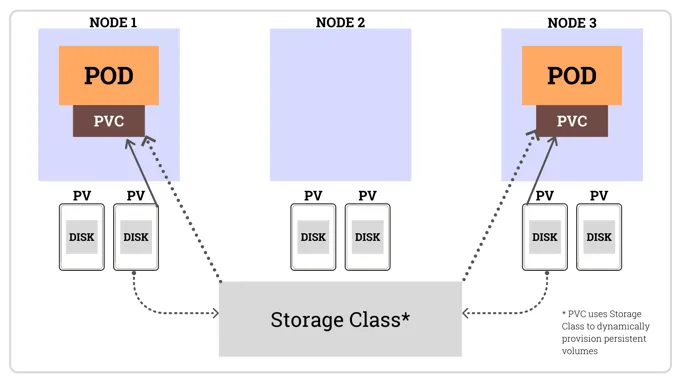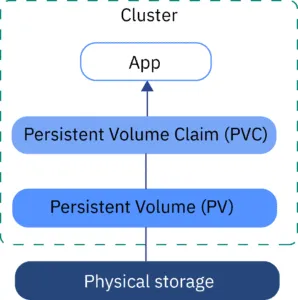Static vs Dynamic Provisioning in Kubernetes: Deep Dive into Persistent Storage 🛠️
In the world of Kubernetes, managing persistent storage is crucial when dealing with stateful applications like databases or services that need to retain data even after a pod is destroyed. One key aspect is provisioning storage, which can be handled using static or dynamic provisioners. Let’s dive into what they are and how they work! 🚀
Static Provisioning 📦
With static provisioning, the admin manually creates the storage resources (like a Persistent Volume or PV) ahead of time. These volumes are fixed and predefined, meaning they need to exist before a pod can claim them. Think of it as pre-ordering storage space—pods get assigned to these volumes that already exist.
👉 Scenario: If you know exactly how much storage you need, and you want complete control over your storage resources, static provisioning is a good option. However, it lacks flexibility because volumes must be created beforehand.
Dynamic Provisioning ⚙️
Dynamic provisioning allows Kubernetes to automatically create storage resources on demand when a Persistent Volume Claim (PVC) is made. You don’t have to create Persistent Volumes (PV) manually—Kubernetes does that for you by leveraging a StorageClass.
👉 Scenario: For cloud environments or when you don’t want to manage individual volumes, dynamic provisioning is a better fit. It allows Kubernetes to request and create storage as pods need it, providing flexibility and scalability.
🗄️ What is a StorageClass?
A StorageClass defines how storage is provisioned dynamically. It acts as a blueprint for creating Persistent Volumes and contains details like provisioner type, parameters, and reclaim policies. By specifying a StorageClass, you instruct Kubernetes to provision storage using certain attributes (like SSDs or HDDs, replication settings, etc.). This Storage class can have multiple storage or request storage like AWS S3 , Net App or Azure Storage
Think of it like a catalog of storage types! 📚
Here’s an example of a StorageClass for GCEPersistentDisk:
apiVersion: storage.k8s.io/v1
kind: StorageClass
metadata:
name: fast
provisioner: kubernetes.io/gce-pd
parameters:
type: pd-ssdIn this example, the pd-ssd type will create fast, SSD-backed persistent disks dynamically whenever a PVC requests it!
🗂️ Persistent Volumes (PV) and Persistent Volume Claims (PVC)
Now that we know about provisioners, let’s move to Persistent Volumes (PV) and Persistent Volume Claims (PVC).
Persistent Volumes (PV) 📀
A Persistent Volume is a piece of storage in the cluster that has been provisioned by the admin (in static provisioning) or dynamically by Kubernetes (in dynamic provisioning). A PV is a resource in the cluster, just like nodes or pods.
Persistent Volume Claims (PVC) 🎟️
A Persistent Volume Claim is how pods request storage. Think of a PVC as a ticket a pod uses to claim a specific storage resource (PV). When a pod specifies a PVC, Kubernetes will automatically bind it to an appropriate PV. If no matching PV exists, and you have dynamic provisioning set up, Kubernetes will create one automatically.
Here’s how a PVC works with dynamic provisioning:
- A pod requests storage by making a Persistent Volume Claim (PVC).
- Kubernetes checks if there is an available Persistent Volume (PV) that matches the claim.
- If a matching PV isn’t available, Kubernetes creates one dynamically based on the StorageClass defined.
- The PVC is then bound to the newly created or existing PV.
🧑💻 Example of PVC and Dynamic Provisioning
Here’s an example where a pod requests storage dynamically:
apiversion: v1
kind: PersistentVolumeClaim
metadata:
name: my-pvc
spec:
accessModes:
- ReadWriteOnce
storageClassName: fast
resources:
requests:
storage: 10GiIn this case, when the PVC my-pvc is applied, Kubernetes will dynamically provision a 10Gi Persistent Volume based on the StorageClass called fast (which, as we saw earlier, specifies SSDs). Once provisioned, the PVC will automatically be bound to the PV, and the pod will be able to use that storage.
A Diagrammatic Representation of Storage Class shared between nodes

Another example of Persistent Volume pointing to the application inside the cluster via PVC

TIP
💡 Always use dynamic provisioning for a more scalable, efficient Kubernetes environment! Your infrastructure team will thank you for it! 🙌
🛠️ Wrapping Up: Choosing Static vs Dynamic Provisioning
- Static provisioning: 🛠️ Manually managed volumes, offering full control but limited flexibility.
- Dynamic provisioning: 🔄 Automatically managed volumes, offering flexibility and scalability, especially for cloud-native apps.
When managing storage, dynamic provisioning with StorageClasses is often preferred due to its flexibility and ability to scale with the needs of your pods. 🚀
Have you tried both methods? What challenges have you faced with storage provisioning in Kubernetes? Let me know in the comments! 👇
